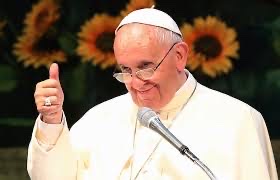Does a Council have the authority to Depose the Pope? "Concilliarism" explained.
Does a Council have the authority to depose a Pope? Welcome to the theory of "Concilliarism"
The meaning and origins of conciliarism and the manner in which it was resolved.
The theory of conciliarism is the theory that a council has the authority to depose a Pope. That supreme authority in the Church resided with an ecumenical council, apart from, or even against, the pope. The foundations of this belief were laid in the early years of the 13th century, when canonists found difficulty in reconciling the increasing claims of Papal authority with the theoretical possibility of a heretical Pope.
Hugh of Pisa (d.1210), taught that a heretical Pope could err, and sought to maintain the inerrancy of the Church by distinguishing between the local Roman Church and the Catholic Church as a whole. In the following century, with the further growth of Papal power, the movement gained support and its principles were invoked in the dispute between Philip IV of France and Boniface VIII, in an attempt to depose the latter. John of Paris (d.1306) taught that the Pope was the steward of God in matters spiritual and temporal; as such he could be deposed for injustice by those who elected him, who had themselves acted as representatives of the whole Christian people. William of Ockham, attacking the indefectibility of both Pope and General Council, sought the fulfilment of the Lord’s promise of the inerrancy of the Church in the survival of truth in any part of it, however obscure.
This belief culminated in a split within the Catholic Church lasting from 1378 to 1417, when multiple men claimed to be pope. On the death of Gregory XI, Urban VI was elected, under considerable pressure by the Roman populace. When, in attempting reforms, he showed signs of insanity, the cardinals withdrew and elected Clement VII, on the grounds that their previous action had been taken under duress. The conciliar movement offered a means of resolving the schism, but the Council of Pisa (1409), only produced another candidate for the papacy. The Council of Constance (1414-18) finally ended the schism by the election of Martin V in 1417.
At council in Pisa, the right is claimed to have the authority to put the popes on trial. They summoned them to appear, both Popes refused, so they elected Alexander V (another anti-pope). Now, we have three people claiming to br pope! So now in many cities you have three bishops, three superiors, etc. After Alexander V, John XXIII is elected.
During the absence of the Popes, Rome had decayed rapidly. The French cardinals wanted Urban VI to return to Avignon where life was more comfortable for them, but Urban refused. The French cardinals, unwilling to give up their lifestyle of luxury, returned to Avignon, declared Urban’s election invalid due to threats from the Roman mob, and elected Clement VII instead. Now we have two rival popes. On the side of Clement VII we have the French, Spain, and Scotland. On the side of Urban VI we have the Roman Empire and England, the northern and eastern nations, and most of the Italian republics. For the next forty years we had two or three rival popes claiming authority. Each of the Popes claimed the right to create cardinals and collect revenues, and each excommunicated the others.
1389 – Urban VI dies, Boniface IX is elected
1394 – Clement VII dies, and Benedict XIII is chosen to replace him
1409 – Council in Pisa, another Pope, Alexander V, is elected. Now there are three.
Pisa was not an ecumenical council. It was the first attempt to put into practice the theory that a General Council is superior to the Pope. In 1414, John XXIII summoned the Council of Constance. John was attending it in person, because he hoped that it would confirm him as Sovereign Pontiff.
The Council of Constance was one of the most memorable in the history of the Church. When John XXIII saw that he was not going to be acknowledged as Pope, he fled, but was captured, returned to the Council, and deposed. Gregory XII, the true Pope, by a solemn act declared the Council true and legitimate. After that, Gregory abdicated the papacy. Benedict XIII was deposed on July 16, 1417. The next step of the Council was to elect a new Pontiff. The choice was Cardinal Otto Colonna, who took the name of Martin V. The council was dissolved in May, 1418. The new Pope approved “all that the Council had resolved as a Council in matters of faith,”, rejecting the decrees which had declared that the Council had authority even over the Pope.
However, conciliarism was not dead yet. At the Council of Basel in 1431, the Council deposed Pope Eugene IV, and renewed the schism by electing an anti-pope, Felix V. This was the last anti-pope in the history of the Church. In 1459, the real Pope, Nicholas V, dissolved the Council, practically ending the conciliar period. In 1459, Pope Pius II forbade all appeals to a General Council, thereby driving a stake through the heart of conciliarism forever.
The failure of the conciliar theory to win general acceptance after the 15th century may be taken as one of the indirect factors leading to the Reformation.


Comments
Post a Comment